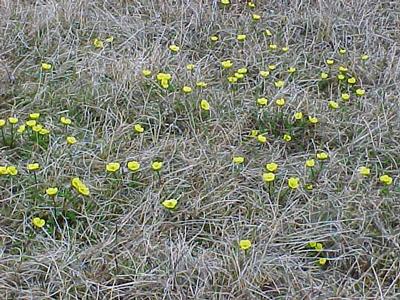26 June, 2001
Tuesday
The first day of rain all day. You can tell the weather is getting
warmer; the ice blocks on the ocean are shrinking, the ocean is changing
into water and every once in a while a mosquito is spotted by someone.
Fog and a gentle, constant rain fell all day but with out trusty Gore-Tex
jackets we braved the elements to go out into the field and count more
plants in Glen's plots. We completed two plots this morning and three
this afternoon, only 11 to go! We'll have a 4th person tomorrow, Lettie,
is flying into Barrow this evening from San Diego to join the team till
August. She is an undergrad science major in the same program Michelle
is in. We will be happy to see her!
Like rainy days most places things seemed quieter than usual. The fog
rolled in from the beach and you could see it drifting across the road on
our drive back for lunch. After lunch we were rewarded for our
perseverance, the fox came to visit us twice today. She doesn't seem to
be bothered by us at all. She walked straight up to us this afternoon but
I must have had shutter shock because my picture only shows her ears.
Counting plants - we will be spending days doing this, why is it so
important? Glen is wanting to track growth patterns in a number of
species under different conditions possible as a result of changing
climate here in the arctic. His treatments are tundra with differing
water levels and heating amounts. Within the 18 plots at his site he has
chosen to measure 4 species, one grass and 3 vascular plants. We are
taking down the initial measurements this week and will relocate the same
plants in approximately 3 weeks to re-measure them. At the end of the
season Glen will again relocate the same plants and do final measurements.
The repeatability is an important part of this part. Without a way to
find the same plants three times over our data would not be worthwhile.
In this way he will be able to track growth patterns, and growth rates of
a representative number of each species types. Adding the treatments in
each plot he can then compare if certain plot variables are more favorable
to growth or not.
There are five main growth variables for arctic vegetation: temperature,
snow free period, light quality, nutrient availability and soil moisture.
Logically one would think that if the climate warms more plants would grow
thus acting as a sink for CO2. What has been happening however is rather
counterintuitive for the most part. Plants, after a short spurt in
production, cannot continue photosynthesizing at an accelerated rate due
to lack of nutrients in the arctic soil. Tundra soil, while composed of
peat, has its nutrients locked up in unusable forms of nitrogen thus
unavailable for plants. The greening of the arctic will probably not
occur as a result of a warmer climate. With a warmer climate, as Glen's
heated plots are simulating, plant respiration increases with increased
root production and this process releases more CO2 into the atmosphere.
The soil moisture is related to this. More bacteria and decomposers can
operate in an underground atmosphere where more pore spaces are open due
to drying soils. So with warmer temperatures, more plant respiration,
more CO2 released equals positive feedback of a warmer climate. The
plants become a net source of CO2.
Glen wants to try and define this more specifically to see if he can
determine what each specific species will do in the overall picture. How
much CO2 flux is occurring will also be looked at on a species level. We
will take flux measurements of individual plants, estimate the % makeup in
the plot and then with the cuvette measurements of the entire plot taken
during diurnals try and proportion the CO2 flux for each of the four
individual species for each given treatment.
The past diurnal we completed about a week ago produced data
representative of last years but there were some leaky plots. Since then
the cuvette has been worked on and the next diurnal is scheduled for this
Monday.

The weather changed but like the mail we keep going until the job is done!

Testing the radios! Doesn't look like Stan and Michelle are on the same band as the rest of us.

The buttercups, Ranunculus nivalis, are out in force now. This could almost be considered a carpet by arctic standards. The tundra is getting greener by the day and we expect to see more flowers soon.
Contact the TEA in the field at
.
If you cannot connect through your browser, copy the
TEA's e-mail address in the "To:" line of
your favorite e-mail package.
|
